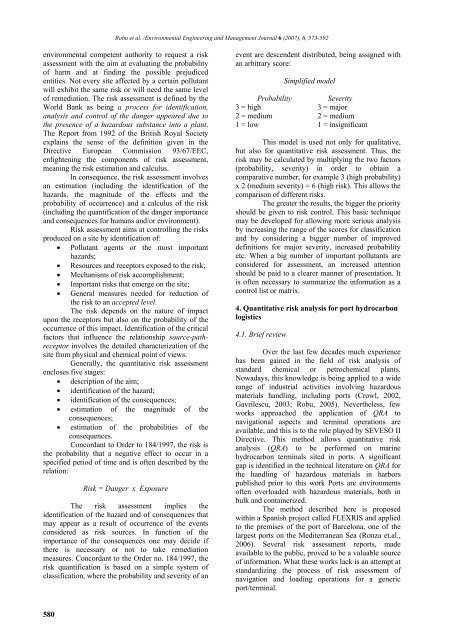2007_6_Nr6_EEMJ
You also want an ePaper? Increase the reach of your titles
YUMPU automatically turns print PDFs into web optimized ePapers that Google loves.
Robu et al. /Environmental Engineering and Management Journal 6 (<strong>2007</strong>), 6, 573-592<br />
environmental competent authority to request a risk<br />
assessment with the aim at evaluating the probability<br />
of harm and at finding the possible prejudiced<br />
entities. Not every site affected by a certain pollutant<br />
will exhibit the same risk or will need the same level<br />
of remediation. The risk assessment is defined by the<br />
World Bank as being a process for identification,<br />
analysis and control of the danger appeared due to<br />
the presence of a hazardous substance into a plant.<br />
The Report from 1992 of the British Royal Society<br />
explains the sense of the definition given in the<br />
Directive European Commission 93/67/EEC,<br />
enlightening the components of risk assessment,<br />
meaning the risk estimation and calculus.<br />
In consequence, the risk assessment involves<br />
an estimation (including the identification of the<br />
hazards, the magnitude of the effects and the<br />
probability of occurrence) and a calculus of the risk<br />
(including the quantification of the danger importance<br />
and consequences for humans and/or environment).<br />
Risk assessment aims at controlling the risks<br />
produced on a site by identification of:<br />
• Pollutant agents or the most important<br />
hazards;<br />
• Resources and receptors exposed to the risk;<br />
• Mechanisms of risk accomplishment;<br />
• Important risks that emerge on the site;<br />
• General measures needed for reduction of<br />
the risk to an accepted level.<br />
The risk depends on the nature of impact<br />
upon the receptors but also on the probability of the<br />
occurrence of this impact. Identification of the critical<br />
factors that influence the relationship source-pathreceptor<br />
involves the detailed characterization of the<br />
site from physical and chemical point of views.<br />
Generally, the quantitative risk assessment<br />
encloses five stages:<br />
• description of the aim;<br />
• identification of the hazard;<br />
• identification of the consequences;<br />
• estimation of the magnitude of the<br />
consequences;<br />
• estimation of the probabilities of the<br />
consequences.<br />
Concordant to Order to 184/1997, the risk is<br />
the probability that a negative effect to occur in a<br />
specified period of time and is often described by the<br />
relation:<br />
Risk = Danger x Exposure<br />
The risk assessment implies the<br />
identification of the hazard and of consequences that<br />
may appear as a result of occurrence of the events<br />
considered as risk sources. In function of the<br />
importance of the consequences one may decide if<br />
there is necessary or not to take remediation<br />
measures. Concordant to the Order no. 184/1997, the<br />
risk quantification is based on a simple system of<br />
classification, where the probability and severity of an<br />
event are descendent distributed, being assigned with<br />
an arbitrary score:<br />
Simplified model<br />
Probability Severity<br />
3 = high 3 = major<br />
2 = medium 2 = medium<br />
1 = low 1 = insignificant<br />
This model is used not only for qualitative,<br />
but also for quantitative risk assessment. Thus, the<br />
risk may be calculated by multiplying the two factors<br />
(probability, severity) in order to obtain a<br />
comparative number, for example 3 (high probability)<br />
x 2 (medium severity) = 6 (high risk). This allows the<br />
comparison of different risks.<br />
The greater the results, the bigger the priority<br />
should be given to risk control. This basic technique<br />
may be developed for allowing more serious analysis<br />
by increasing the range of the scores for classification<br />
and by considering a bigger number of improved<br />
definitions for major severity, increased probability<br />
etc. When a big number of important pollutants are<br />
considered for assessment, an increased attention<br />
should be paid to a clearer manner of presentation. It<br />
is often necessary to summarize the information as a<br />
control list or matrix.<br />
4. Quantitative risk analysis for port hydrocarbon<br />
logistics<br />
4.1. Brief review<br />
Over the last few decades much experience<br />
has been gained in the field of risk analysis of<br />
standard chemical or petrochemical plants.<br />
Nowadays, this knowledge is being applied to a wide<br />
range of industrial activities involving hazardous<br />
materials handling, including ports (Crowl, 2002,<br />
Gavrilescu, 2003; Robu, 2005). Nevertheless, few<br />
works approached the application of QRA to<br />
navigational aspects and terminal operations are<br />
available, and this is to the role played by SEVESO II<br />
Directive. This method allows quantitative risk<br />
analysis (QRA) to be performed on marine<br />
hydrocarbon terminals sited in ports. A significant<br />
gap is identified in the technical literature on QRA for<br />
the handling of hazardous materials in harbors<br />
published prior to this work Ports are environments<br />
often overloaded with hazardous materials, both in<br />
bulk and containerized.<br />
The method described here is proposed<br />
within a Spanish project called FLEXRIS and applied<br />
to the premises of the port of Barcelona, one of the<br />
largest ports on the Mediterranean Sea (Ronza et.al.,<br />
2006). Several risk assessment reports, made<br />
available to the public, proved to be a valuable source<br />
of information. What these works lack is an attempt at<br />
standardizing the process of risk assessment of<br />
navigation and loading operations for a generic<br />
port/terminal.<br />
580


